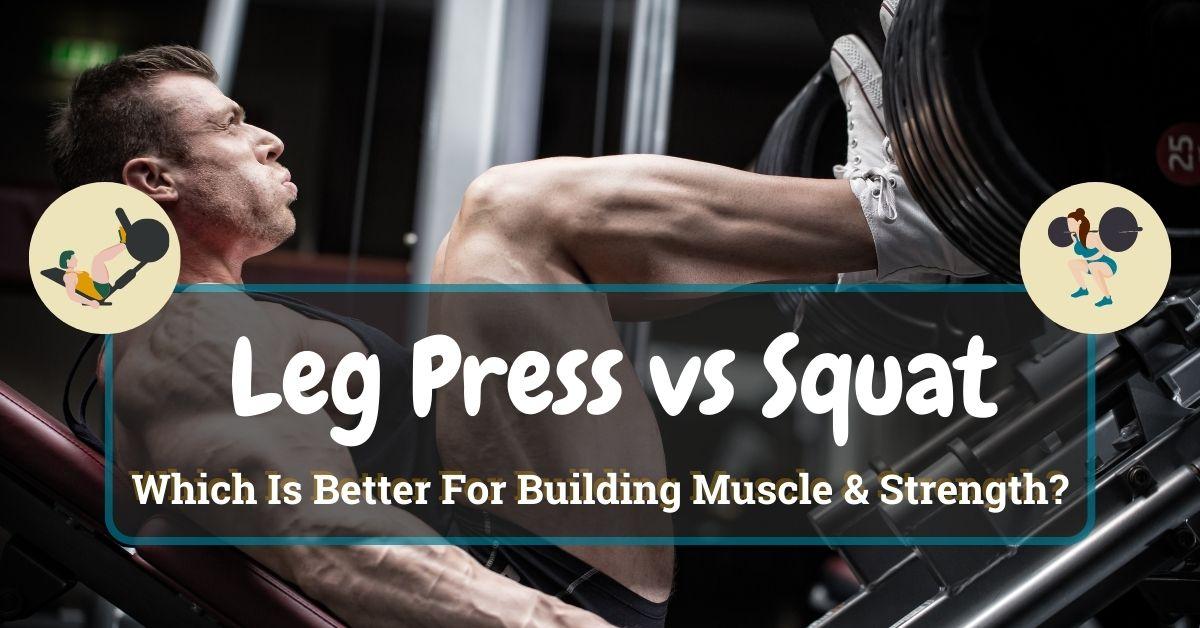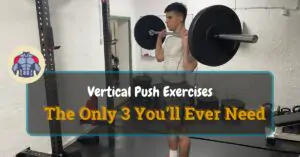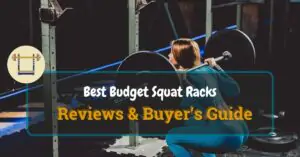Are you looking to build strong, toned legs?
Table of Contents
Toggle“Leg press vs squat” is a common debate among fitness enthusiasts when choosing the best exercise for achieving lower body goals.
But which one is better for building muscle and strength?
As a Faculty of Sport and Physical Education student, it took me over 30 hours to research the topic of leg press vs. squat and compile all the necessary information.
In this blog post, I will dive deep into the mechanics, benefits, and factors to consider when choosing between these two powerhouse exercises.
Start Building Your Dream Body Today
Ready to elevate your fitness game without falling into the trap of dull, repetitive routines that just don’t deliver? Imagine sculpting your ideal physique and boosting your health, all while still enjoying life’s pleasures, like those irresistible weekend getaways and your aunt’s legendary cheesecake. With our online fitness and nutrition coaching service, you don’t have to compromise. Dive into a personalized fitness journey that blends perfectly with your lifestyle, not against it. Book your completely free discovery consultation today, and take the first step towards a transformation that doesn’t require giving up the joys of life.

“I was skeptical about online fitness coaching, but Functional Body Savage completely changed my perspective. Vanja and Radomir’s personalized approach and attention to detail have helped me achieve goals I never thought possible. I’m stronger, more confident, and grateful for their guidance.”
Emily Thompson, San Francisco, CA
Learn More About Our Online Coaching ServiceQuick Summary
- Leg press and squats are both effective exercises to build muscle & strength, with leg press offering a reduced risk of injury for beginners.
- Squats provide functional strength through total body engagement and increased hormonal response for greater gains.
- Consider personal goals, fitness level and injury history when choosing which exercise is suitable. Combining the two in an appropriate workout routine can also yield great results.
Understanding Leg Press and Squat
Leg press and squat are both effective exercises for targeting the lower body muscles, but they differ in terms of mechanics and muscle activation.
The leg press machine is designed to isolate specific muscle groups, while the squat is a free-weight exercise that engages the entire body.
Understanding the differences between these two exercises is crucial in determining which one is best suited for your fitness goals and needs.
Leg press exercises are performed on a machine that guides the movement path, allowing for more targeted muscle growth.
On the other hand, squat exercises involve lifting a barbell or using body weight, engaging multiple muscle groups and requiring more stability and coordination.
Both exercises can be beneficial for building leg strength and muscle mass, but their unique mechanics make them suitable for different fitness levels and goals.
Leg Press Mechanics
The leg press exercise involves a fixed movement path, isolating the quadriceps muscles and reducing stress on the lower back.
There are two common types of leg press machines: one with the legs at a 45-degree angle and another with the user in a seated leg press position.
Both the leg press machines allow for targeted muscle growth in the quads, hamstrings, and glutes, making leg presses an effective leg workout choice.
Adjusting foot width on the leg press machine can effectively target various leg muscles.
In contrast to squats, leg press machines place the legs at a 90-degree angle relative to the body, offering a more focused workout for the quads and glutes.
The leg press is a simpler movement to learn, as the range of motion is predetermined by the machine.
Squat Mechanics
The barbell squat is a free-weight exercise that engages the entire body, requiring more stability and coordination.
This exercise targets the core, lower back, quads, hamstrings, and glutes, making it a versatile and effective exercise for overall leg strength and muscle development.
There are various squat variations, such as barbell back squats, front squats, and hack squats, allowing for more customized workouts targeting different muscle groups.
Incorporating exercises like barbell squats and using a hack squat machine into your routine can help improve overall strength and stability.
Squats involve a greater knee bend compared to other exercises.
This activates the quads more significantly.
However, they require balance, coordination, and confidence, making them a more complex exercise to master.
The free-weight nature of squats means the risk of injury is higher if performed incorrectly, emphasizing the importance of proper form and technique.
To learn more about squat mechanics and the proper technique and form, read our guide on performing squats correctly for maximal benefits and a smaller chance of injury.
What Are the Benefits of Leg Press?
The benefits of leg press are listed below.
- Targeted muscle growth
- Reduced risk of injury
- Beginner-friendly
When considering leg press vs squat, it’s important to acknowledge the benefits each exercise has to offer.
Leg press provides targeted muscle growth, focusing on the quads and glutes, as well as a reduced risk of injury due to its fixed movement path.
Moreover, the leg press is a beginner-friendly exercise, with a lower learning curve and minimal coordination requirements compared to the squat.
The squat, on the other hand, is a compound exercise that works multiple muscle groups.
Targeted Muscle Growth
The leg press allows for focused muscle growth in the quads and glutes, as it isolates these specific muscle groups during the exercise [1].
This targeted approach can be beneficial for those looking to develop lean muscle mass and strong leg muscles, especially when used in conjunction with other leg workouts and exercises.
It can be a great way to add variety to your leg routine and help you reach your fitness goals.
Reduced Risk of Injury
The fixed movement path of the leg press reduces the risk of injury compared to squats.
By eliminating the need to balance heavy weights on the spine, the leg press offers a safer alternative for those who may be concerned about the potential for injury during free-weight exercises like squats.
This makes the leg press an ideal choice for those who are new to strength training or who may be new to strength training.
Beginner-Friendly
Due to its machine-based nature, the leg press is an ideal exercise for beginners who may be intimidated by free-weight exercises like squats.
The leg press requires less motor control and coordination, making it an accessible entry point for those just starting their fitness journey or looking to build a solid foundation in lower body strength training.
What Are the Benefits of Squats?
The benefits of squats are listed below.
- Functional strength development
- Total body engagement
- Hormonal response
Squats, on the other hand, offer their own set of unique benefits.
These exercises provide functional strength development, total body engagement, and a stronger hormonal response.
The compound nature of squats makes them a powerful tool for overall muscle development and strength gains.
Functional Strength Development
Squats improve overall functional strength, enhancing balance, coordination, and agility [2].
By engaging multiple muscle groups simultaneously, squats offer a more comprehensive approach to lower body training.
This translates to increased athletic performance and everyday functional movements.
Total Body Engagement
Squats engage more muscles throughout the body, including the core and lower back, making them a great exercise for total body activation [3].
This full-body engagement not only aids in muscle development but also helps improve overall balance and coordination, essential for functional strength and athletic performance.
Hormonal Response
Squats elicit a greater hormonal response than leg press exercises, promoting muscle growth and strength gains [4].
The increased release of hormones like testosterone and growth hormone during squat exercises can positively impact muscle development, making squats a valuable addition to any strength training program.
Squats are a great way to build strength and muscle mass.
What Factors to Consider When Choosing Between Leg Press or Squat?
The factors to consider when choosing between leg press or squats are listed below.
- Personal goals
- Fitness level
- Injury history
When deciding between leg press and squat, it’s crucial to consider your personal goals, fitness level, and injury history.
By evaluating these factors, you can make an informed decision on which exercise is the best fit for your unique needs and objectives.
Both exercises are beneficial for building strength and muscle, but they target different muscle groups and require different training.
Personal Goals
Consider your specific fitness goals when choosing between leg press and squat.
If your primary objective is targeted muscle growth in the quads and glutes, the leg press may be the better option.
However, if you’re looking to develop overall functional strength and engage multiple muscle groups, squats may be the more suitable choice.
Fitness Level
Evaluate your current fitness level and experience with weightlifting exercises before deciding between leg press and squat.
If you’re a beginner or have limited experience with free-weight exercises, the leg press might be a more accessible starting point.
Conversely, if you’re more experienced and comfortable with free-weight exercises, squats can offer greater challenges and rewards.
Injury History
Take into account any past or current injuries that may affect your ability to perform either exercise safely.
If you have a history of lower back or knee issues, the leg press may be a safer alternative to squats.
However, it’s always best to consult with a fitness professional or healthcare provider before beginning any new exercise regimen, especially if you have a history of injuries.
How to Combine Leg Press and Squats in a Workout Routine?
To combine leg press and squats in a workout routine you must consider exercise order, frequency, and intensity.
Combining squat and leg press exercises in a workout routine can provide a well-rounded approach to lower body training, allowing you to reap the benefits of both exercises.
By finding the right balance between these two exercises, you can create a comprehensive and effective workout plan tailored to your individual goals and needs.
This plan should be tailored to your individual goals and needs, and should include the right balance.
Exercise Order
Determining the best exercise order for your goals is crucial when combining leg press and squat in a workout routine.
If your primary goal is functional strength development, consider performing squats first, followed by leg press for targeted muscle growth.
Alternatively, if muscle isolation and growth are your main objectives, you may choose to perform the leg press first, followed by squats for total body engagement.
However, it would be smarter to perform squats first since the risk of injury increases the further away you place them in the workout.
Demanding compound exercises such as squats should always be placed first in the workout.
Frequency and Intensity
Adjust the frequency and intensity of each exercise to suit your individual needs and recovery abilities.
For example, beginners may start with lighter weights and higher repetitions, gradually increasing the intensity as they become more comfortable with the exercises.
More advanced lifters may prioritize heavier weights and lower repetitions to maximize strength gains and muscle development.
Remember to listen to your body and adjust your workout routine accordingly to ensure optimal results and minimize the risk of injury.
FAQs
Can Leg Press Replace Squats?
In short, no, the leg press can not replace squats. Squats target many more muscles than just the quads, including the glutes, hamstrings, and core – all important areas in building a well rounded lower body.
How Much Leg Press Compared to Squat?
Based on expert advice, leg press capacity typically far surpasses squat strength for many people – generally 2-3 times more weight can be pressed than can be squatted. This demonstrates the substantial strength in the lower body when engaging in a leg press as opposed to a squat.
Is Leg Press More Like Squat or Deadlift?
The leg press is more like a squat than a deadlift. This is because the leg press works the quads similarly and engages the glutes, hamstrings, and back.
Does Leg Press Reduce Belly Fat?
The leg press doesn’t reduce belly fat. To reduce belly fat, focus on a healthy diet and combine your leg press exercises with other forms of cardiovascular activity.
Leg Press Works What Muscles?
The leg press works leg muscles, including the quadriceps, glutes, hamstrings and calves. With proper form and technique, the leg press can effectively help you reach your strength-training and muscle-building goals.
Leg Press vs Squat – Summary
In conclusion, both leg press and squat exercises offer unique benefits in building muscle and strength in the lower body.
By considering your personal goals, fitness level, and injury history, you can make an informed decision on which exercise is the best fit for your workout routine.
Whether you choose to focus on one exercise or incorporate both into your regimen, remember that consistency, proper form, and dedication are essential for achieving optimal results and improving your overall fitness and health.
Start Building Your Dream Body Today
Ready to elevate your fitness game without falling into the trap of dull, repetitive routines that just don’t deliver? Imagine sculpting your ideal physique and boosting your health, all while still enjoying life’s pleasures, like those irresistible weekend getaways and your aunt’s legendary cheesecake. With our online fitness and nutrition coaching service, you don’t have to compromise. Dive into a personalized fitness journey that blends perfectly with your lifestyle, not against it. Book your completely free discovery consultation today, and take the first step towards a transformation that doesn’t require giving up the joys of life.

“I was skeptical about online fitness coaching, but Functional Body Savage completely changed my perspective. Vanja and Radomir’s personalized approach and attention to detail have helped me achieve goals I never thought possible. I’m stronger, more confident, and grateful for their guidance.”
Emily Thompson, San Francisco, CA
Learn More About Our Online Coaching ServiceReferences:
- https://www.ncbi.nlm.nih.gov/pmc/articles/PMC7700405/
- https://pubmed.ncbi.nlm.nih.gov/27735888/
- https://www.ncbi.nlm.nih.gov/pmc/articles/PMC5435978/
- https://pubmed.ncbi.nlm.nih.gov/30531700/





